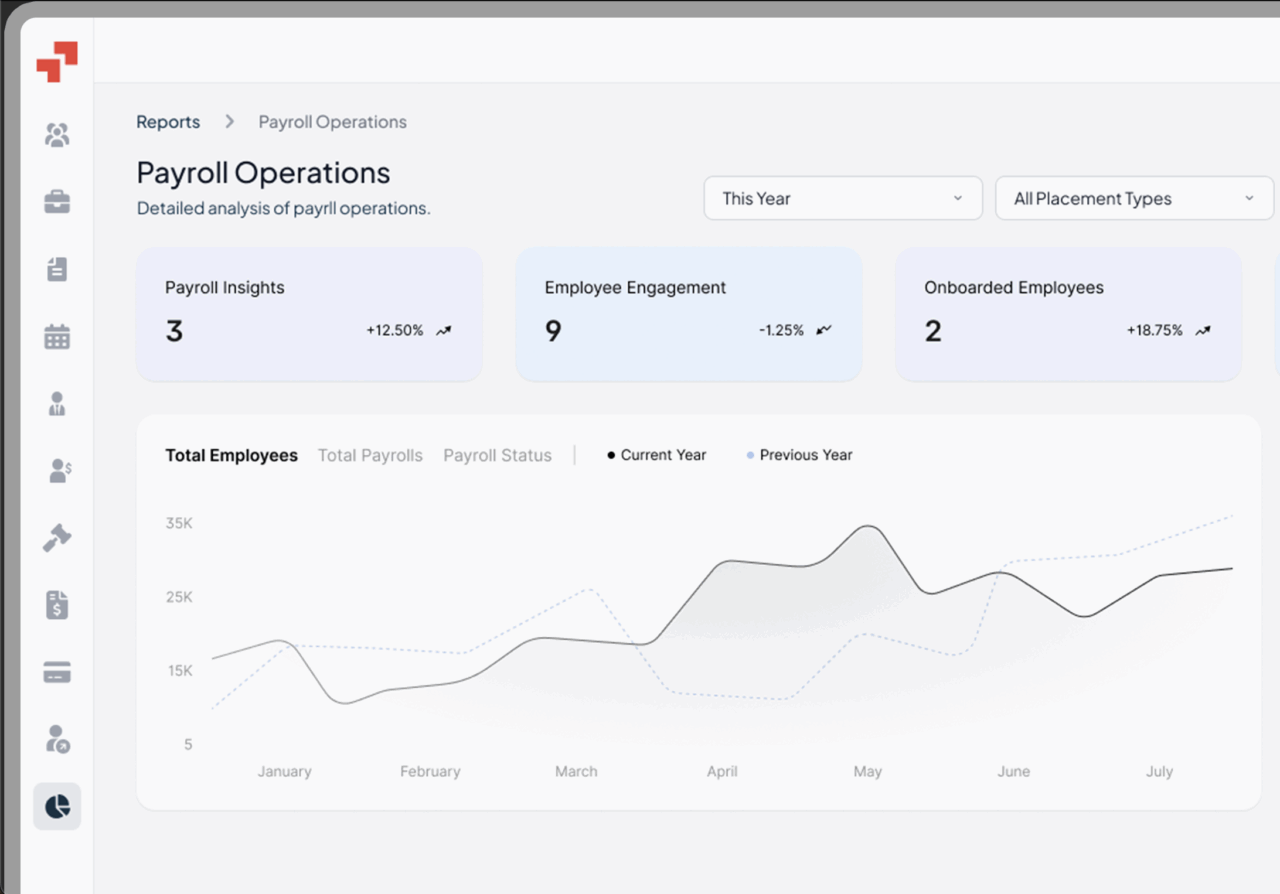Global Workforce GlossaryPayroll Cycle
Paying employees accurately and on time is one of the biggest challenges for growing businesses. A mismanaged payroll cycle can lead to errors, compliance risks, and cash flow headaches. Understanding how payroll cycles work—from weekly pay schedules to monthly payroll cycles—helps HR teams and business leaders streamline payroll system processing, reduce costs, and maintain employee satisfaction. across the organization.
Table of Contents
- What is a Contract Employee?
- How to Be a Contract Employee
- What are the Benefits of a Contract Employee
- Can a Contract Employee Become Permanent?
- Benefits of Hiring Contract Employees
- How Do Contract Workers Get Paid?
- Is There a Difference Between a Contract Employee and an Independent Contractor?
- What is the Difference Between a Contract Employee and an Internal Employee?
- Does Contract Work Count as Employment?
- Is a Contract Employee the Same as a 1099 Employee?
- How to Onboard and Manage Contract Employees
- Contract Employee Example
- PamGro: Your Partner in Hiring Contract Employees Globally
What is Payroll Cycle?
A payroll cycle is the recurring schedule a company follows to process and distribute employee wages. It defines how often employees are paid and ensures payroll processing is accurate, timely, and compliant. The payroll cycle includes the entire period from one payroll to the next.
A properly managed payroll cycle impacts cash flow patterns, payroll costs, and employee satisfaction. Companies that adopt automated payroll cycles can reduce errors by up to 40% and improve efficiency significantly. Common payroll cycles include weekly, bi-weekly, semi-monthly, and monthly pay schedules. The bi-weekly pay cycle is the most common type of payroll cycle in the United States. U.S. Department of Labor – Payroll Guidelines provides legal insights for structuring payroll cycles.
What Does Off-Cycle Payroll Mean?
Off-cycle payroll is a payroll run conducted outside the regular payroll cycle, typically used to correct errors, process payroll terminations, handle payroll tasks, or issue urgent bonuses.
While regular payroll cycles follow a predictable schedule, off-cycle payrolls are exceptions that require additional administrative effort, especially in managing payroll deductions . Minimizing off-cycle payroll reduces payroll costs, administrative errors, and delays. Tools like PamGro’s payroll services help HR teams manage off-cycle payroll efficiently so that employees receive paychecks on time , especially for international employees. IRS – Payroll Tax Compliance offers guidance on tax reporting for off-cycle payroll.
How Does Payroll Cycle Work?
A payroll cycle works by collecting employee data, calculating wages within defined payroll periods , deducting taxes and benefits, processing payments, and generating compliance reports.
HR and payroll departments collaborate to ensure hours, salaries, and deductions are accurate. Efficient payroll cycle management aligns payments with cash flow patterns, reduces payroll costs, and ensures compliance with employment laws. Automation and payroll software make payroll processing faster, more accurate, and less prone to errors. Companies expanding globally can integrate international payroll schedules for hourly workers and different pay schedules to maintain uniformity across teams in different countrie . to maintain uniformity across teams in different countries.
The Role of HR in Managing Payroll Cycles
HR teams are critical in managing payroll cycles. Their responsibilities include verifying employee records, tracking hours, applying payroll policies, and coordinating with finance.
HR ensures payroll cycles comply with labor laws and reduces the need for off-cycle payroll. By leveraging platforms like PamGro, businesses can automate payroll calculations, track global pay periods, and manage international compliance efficiently, saving both time and resources. HR teams also play a role in employee education, ensuring staff understand pay periods, employee bank accounts, deductions, and benefits., which improves satisfaction and trust
How to Choose a Payroll Cycle?
Selecting the right payroll cycle depends on business size, cash flow, and employee expectations. Options include weekly pay schedules, bi-weekly pay cycles, semi-monthly cycles, and monthly payroll cycles.
Smaller businesses may prefer monthly payroll for simplicity, while companies with hourly employees often benefit from weekly or bi-weekly schedules. HR should evaluate payroll costs, administrative effort, and compliance needs and ensure fair compensation before finalizing a cycle. Incorporating employee feedback can also help select the most suitable pay cycle, improving engagement and retention. SHRM – Payroll Cycle Best Practices provides practical advice for choosing the most suitable pay schedule.
How to Manage Payroll Cycle
Managing a payroll cycle involves accurate data collection, processing, and timely disbursement in the context of a new payroll cycle . Automation tools can track hours, calculate deductions, and generate reports, reducing errors and ensuring the pay date is on time off-cycle runs.
Steps include defining clear payroll policies, reconciling payroll with accounting, auditing employee data, and coordinating between HR and finance. For global teams, payroll management also requires understanding local labor laws, tax rates, and benefits requirements. Efficient management ensures regular payroll cycles run smoothly, costs are controlled, and employee satisfaction remains high. Using a platform like PamGro simplifies payroll management, especially for multi-country teams, by automating processes and ensuring local compliance.
What Are 3 Stages of Payroll?
The payroll cycle typically has three stages:
- Data Collection: Gathering timesheets, attendance, and benefits information. A typical payroll cycle includes employee data management, time and attendance tracking, gross salary calculation, and deduction processing.
- Processing: Calculating gross pay, deductions, and net pay.
- Disbursement: Issuing payments and maintaining compliance reports.
Understanding these stages helps HR and finance teams streamline operations, reduce off-cycle payroll runs, and improve payroll accuracy. In practice, mapping out these stages clearly reduces errors and improves operational transparency.
What Are the Steps of the Payroll Cycle?
A typical payroll cycle process includes:
- Collect employee hours, attendance, and benefits.
- Calculate gross wages and applicable deductions.
- Approve payroll and process payments.
- Generate compliance reports for accounting and legal purposes.
Following these steps ensures timely payments, accurate reporting, and smooth cash flow management. Tools like PamGro help automate these steps, making payroll cycle management efficient even for international teams. Adding cross-checks and reconciliation steps can further reduce errors and off-cycle adjustments. Distribute the net pay to the employee at the end of each payroll cycle in the form of paycheck, cash, or direct deposit payments.
What are the Common Payroll Cycle Types
Payroll cycles vary based on frequency and business needs:
- Weekly pay schedule: Employees are paid every week; common for hourly staff. A weekly pay cycle pays employees once a week, resulting in 52 payments per year.
- Bi-weekly pay schedule: Paid every two weeks; widely adopted in U.S. companies. A bi-weekly pay cycle pays employees every two weeks, totaling 26 pay periods per year.
- Semi-monthly pay cycle: Paid on fixed dates, e.g., 15th and 30th of the month. A semi-monthly pay cycle results in two payments each month, totaling 24 paychecks annually.
- Monthly payroll cycle: Paid once per month; often preferred by small businesses.
Each type affects payroll costs, cash flow patterns, and administrative workload. Businesses should align payroll schedules with operational and financial goals. International companies may combine multiple cycle types across countries to accommodate local labor laws, which PamGro can help manage seamlessly.
Off-Cycle Payroll vs. Regular Payroll Cycle: What Is the Difference?
Regular payroll cycles follow fixed, recurring schedules, providing predictability for HR and employees. Off-cycle payrolls occur outside this schedule for corrections, terminations, or bonuses, including semi monthly payments .
Minimizing off-cycle payrolls reduces administrative workload and payroll costs. Weekly pay cycles can increase administrative workload and costs for HR teams. Platforms like PamGro enable businesses to handle off-cycle runs efficiently while maintaining compliance with federal income tax and keeping employees paid accurately on schedule. Off-cycle payroll management is especially critical for companies operating in multiple countries with varying local payroll requirements.
Practical Example of a Payroll Cycle
Consider a SaaS company with a bi-weekly payroll cycle. Employees submit timesheets by Friday. HR validates them on Monday, payroll is processed Tuesday, and payments are issued Wednesday. Reports are completed by Friday.
For global teams, PamGro EOR services streamline this process across multiple countries. They ensure compliance with local tax laws, automate payroll calculations, handle currency conversions, and manage employee benefits. This reduces administrative time, prevents errors, and guarantees timely payments, improving employee satisfaction and operational efficiency. Companies can integrate PamGro’s platform into their workflow to support both standard and off-cycle payrolls without extra overhead.
PamGro: Simplifying Global Hiring and Compliance
Managing payroll cycles—especially for international teams—can be complex. PamGro’s EOR services simplify global payroll by handling compliance with local laws including the internal revenue service , taxes, and timely payments.
With PamGro, businesses can automate payroll cycles, reduce off-cycle payroll errors, and ensure employees worldwide are paid on schedule. Explore how PamGro’s global payroll solutions streamline operations, optimize cash flow, and support international expansion.
Hire the Best Talent, Anywhere






